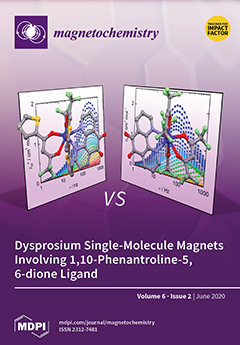A review of the tripodal Schiff base (SB) complexes of tris(2-aminoethyl)amine, N
ap(CH
2CH
2NH
2)
3 (tren), and a few closely related tripodal amines with Cr(II), Mn(III) (d
4), Mn(II), Fe(III) (d
5), Fe(II) (d
6
[...] Read more.
A review of the tripodal Schiff base (SB) complexes of tris(2-aminoethyl)amine, N
ap(CH
2CH
2NH
2)
3 (tren), and a few closely related tripodal amines with Cr(II), Mn(III) (d
4), Mn(II), Fe(III) (d
5), Fe(II) (d
6), and Co(II) (d
7) is provided. Attention is focused on examination of key structural features, the M-N
imine, M-N
amine, or M-O and M-N
ap bond distances and N
imine-M-N(O) bite and C-N
ap-C angles and how these values correlate with spin state selection and spin crossover (SCO) behavior. A comparison of these experimental values with density functional theory calculated values is also given. The greatest number, 132, of complexes is observed with cationic mononuclear iron(II) in a N
6 donor set, Fe(II)N
6. The dominance of two spin states, high spin (HS) and low spin (LS), in these systems is indicated by the bimodal distribution of histogram plots of Fe(II)-N
imine and Fe(II)-N
azole/pyridine bond distances and of N
imine–Fe(II)-N
azole/pyridine and C-N
ap-C bond angles. The values of the two maxima, corresponding to LS and HS states, in each of these histograms agree closely with the theoretical values. The iron(II)-N
imine and iron(II)-N
azole/pyridine bond distances correlate well for these complexes. Examples of SCO complexes of this type are tabulated and a few of the 20 examples are discussed that exhibit interesting features. There are only a few mononuclear iron(III) cationic complexes and one is SCO. In addition, a significant number of supramolecular complexes of these ligands that exhibit SCO, intervalence, and chiral recognition are discussed. A summary is made regarding the current state of this area of research and possible new avenues to explore based on analysis of the present data.
Full article





